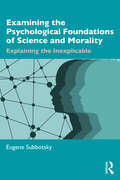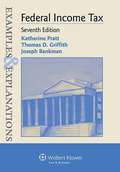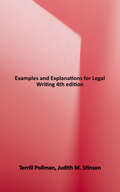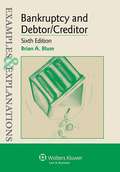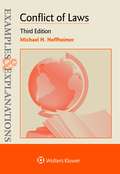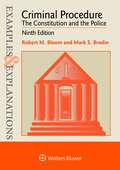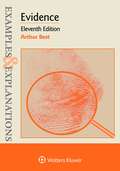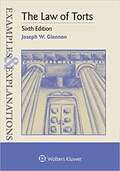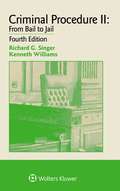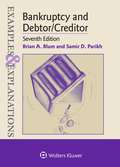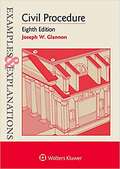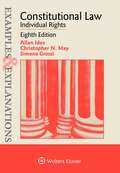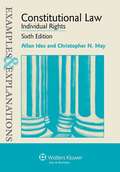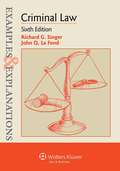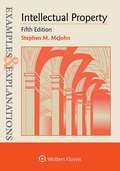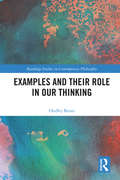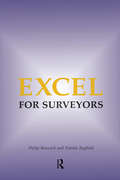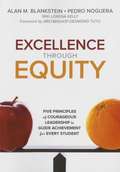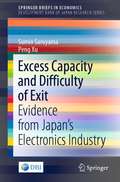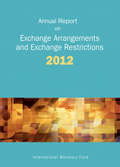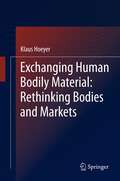- Table View
- List View
Examining Political Violence: Studies of Terrorism, Counterterrorism, and Internal War (International Police Executive Symposium Co-Publications)
by David Lowe Dilip K. Das Austin TurkA collection of works, some previously published as articles in the journal Police Practice and Research, this book provides both conceptual analysis and case studies, exploring historical and sociopolitical contexts of conflicts in order to help readers better understand these themes. The book defines the concepts of terrorism and radicalization, discusses countering terrorism through intelligence gathering, and examines different policing models. The conclusions drawn from these findings may assist in combating terrorism and political violence around the world. This book is a co-publication with the International Police Executive Symposium (IPES).
Examining the Psychological Foundations of Science and Morality: Explaining the Inexplicable
by Eugene SubbotskyExamining the Psychological Foundations of Science and Morality is a progressive text that explores the relationship between psychology, science and morality, to address fundamental questions about the foundations of psychological research and its relevance for the development of these disciplines. Supported by original empirical evidence, the book analyses the relationship of folk psychology to rational knowledge, outlining an original theory that connects psychology and natural sciences through the mind which creates a psychological foundation for scientific knowledge and morality. It argues that science and religion have a common psychological core of subjective experience, which diversifies into knowledge, beliefs and morality. The book considers how subjective space and time are converted into physical space and time, and how subjective ‘sense of causation’ is shaped into physical causality and human communication. Further, it explores the mind as a complex system of contrasting realities, with the main function being existence attribution (EXON). The chapters delve into a range of topics including theoretical analysis of consciousness, the internal self, unexplainable phenomena, analysis of empirical research into causality, morality and the mind. The book will be of great interest to postgraduate and upper-level undergraduate students studying foundations of psychology, consciousness, philosophy of science, morality, as well as professionals who deal with influence on mass consciousness or are interested in the link between human psychology, scientific knowledge and morality.
Examples & Explanations Federal Income Tax,Seventh Edition
by Katherine Pratt Thomas D. Griffith Joseph BankmanA favorite among successful students, and often recommended by professors, the unique Examples & Explanations series gives you extremely clear introductions to concepts followed by realistic examples that mirror those presented in the classroom throughout the semester. Use at the beginning and midway through the semester to deepen your understanding through clear explanations, corresponding hypothetical fact patterns, and analysis. Then use to study for finals by reviewing the hypotheticals as well as the structure and reasoning behind the accompanying analysis. Designed to complement your casebook, the trusted Examples & Explanations titles get right to the point in a conversational, often humorous style that helps you learn the material each step of the way and prepare for the exam at the end of the course.
Examples & Explanations for Legal Writing, Fourth Edition
by Terrill Pollman Judith M. StinsonThe Fourth Edition of Examples and Explanations: Legal Writing explains what many professors consider effective writing, following the organization of typical first-year legal writing courses, and provides concrete examples for students to test their understanding of key legal writing concepts. Each chapter includes a checklist that can be easily transformed into a grading grid as well as chapter-by-chapter vocabulary that integrates your classroom instruction with these examples. This book--whether the entire book, selected chapters, or subsets of chapters--can accompany any legal writing textbook or materials you provide for your students. A favorite classroom prep tool of successful students that is often recommended by professors, the Examples& Explanations series has been ranked the most popular study aid among law students because it is equally as helpful from the first day of class through the final exam. New to the Fourth Edition: - New chapters on common law and on writing conclusion sections in persuasive documents - Revised and updated with legal writing professors in mind, including revisions that work whether assigning single chapters or the entire book - New common law assignments with many added examples and explanations throughout the book Professors and students will benefit from: - Understanding how the writing students do in law school (and law practice) differs from what they did in college - Professors knowing the right way to use examples, although they may hesitate to give examples - Learning how to practice revising and rewriting--skills that are necessary to all good writing - Demonstrations of how to self-evaluate, self-explain, and self-test - Having the tools to continue to learn about legal writing after formal instruction ends
Examples & Explanations: Bankruptcy & Debtor/Creditor Sixth Edition
by Brian A. BlumThis book offers basic overview of debt collection under state law and an introduction to concepts and principles that underlie both state debtor/creditor law and bankruptcy.
Examples & Explanations: Conflict of Laws Third Edition
by Michael H. HoffheimerThis book includes the basic material covered in a standard Conflict of Laws courses. It begins with an overview (Chapter 1) that describes the topics and introduces the jargon. It covers domicile, personal jurisdiction, and forum selection (Part I); choice of law approaches (Parts II-VI); constitutional limits on choice of law (Part VII); rules for enforcing judgments (Part VIII); and proof of foreign law (Part IX).
Examples And Explanations For Criminal Procedure: The Constitution And The Police (Examples And Explanations)
by Robert M. Bloom Mark S. BrodinA favorite classroom prep tool of successful students that is often recommended by professors, the Examples & Explanations (E&E) series provides an alternative perspective to help you understand your casebook and in-class lectures. Each E&E offers hypothetical questions complemented by detailed explanations that allow you to test your knowledge of the topics in your courses and compare your own analysis. Here’s why you need an E&E to help you study throughout the semester: Clear explanations of each class topic, in a conversational, funny style. Features hypotheticals similar to those presented in class, with corresponding analysis so you can use them during the semester to test your understanding, and again at exam time to help you review. It offers coverage that works with ALL the major casebooks, and suits any class on a given topic. The Examples & Explanations series has been ranked the most popular study aid among law students because it is equally as helpful from the first day of class through the final exam.
Examples And Explanations For Evidence (Examples And Explanations Ser.)
by Arthur BestA favorite among successful students, and often recommended by professors, the unique Examples & Explanations series gives you extremely clear introductions to concepts followed by realistic examples that mirror those presented in the classroom
Examples And Explanations For The Law Of Torts (Examples And Explanations Ser.)
by Joseph W. GlannonA favorite among successful students, and often recommended by professors, the unique Examples & Explanations series gives you extremely clear introductions to concepts followed by realistic examples that mirror those presented in the classroom throughout the semester. Use at the beginning and midway through the semester to deepen your understanding through clear explanations, corresponding hypothetical fact patterns, and analysis. Then use to study for finals by reviewing the hypotheticals as well as the structure and reasoning behind the accompanying analysis. Designed to complement your casebook, the trusted Examples & Explanations titles get right to the point in a conversational, often humorous style that helps you learn the material each step of the way and prepare for the exam at the end of the course. The unique, time-tested Examples & Explanations series is invaluable to teach yourself the subject from the first day of class until your last review before the final. Each guide: helps you learn new material by working through chapters that explain each topic in simple language challenges your understanding with hypotheticals similar to those presented in class provides valuable opportunity to study for the final by reviewing the hypotheticals as well as the structure and reasoning behind the corresponding analysis quickly gets to the point in conversational style laced with humor remains a favorite among law school students is often recommended by professors who encourage the use of study guides works with ALL the major casebooks, suits any class on a given topic provides an alternative perspective to help you understand your casebook and in-class lectures
Examples Explanations: Criminal Procedure Ii From Bail To Jail 4e (Examples And Explanations Ser.)
by SingerA favorite classroom prep tool of successful students that is often recommended by professors, the Examples & Explanations (E&E) series provides an alternative perspective to help you understand your casebook and in-class lectures. Each E&E offers hypothetical questions complemented by detailed explanations that allow you to test your knowledge of the topics in your courses and compare your own analysis. Here’s why you need an E&E to help you study throughout the semester: Clear explanations of each class topic, in a conversational, funny style. Features hypotheticals similar to those presented in class, with corresponding analysis so you can use them during the semester to test your understanding, and again at exam time to help you review. It offers coverage that works with ALL the major casebooks, and suits any class on a given topic. The Examples & Explanations series has been ranked the most popular study aid among law students because it is equally as helpful from the first day of class through the final exam.
Examples and Explanations for Bankruptcy and Debtor/Creditor
by Brian A. Blum Samir D. ParikhA favorite among successful students, and often recommended by professors, the unique Examples & Explanations series gives you extremely clear introductions to concepts followed by realistic examples that mirror those presented in the classroom throughout the semester. Use at the beginning and midway through the semester to deepen your understanding through clear explanations, corresponding hypothetical fact patterns, and analysis. Then use to study for finals by reviewing the hypotheticals as well as the structure and reasoning behind the accompanying analysis. Designed to complement your casebook, the trusted Examples & Explanations titles get right to the point in a conversational, often humorous style that helps you learn the material each step of the way and prepare for the exam at the end of the course. <P><P> The unique, time-tested Examples & Explanations series is invaluable to teach yourself the subject from the first day of class until your last review before the final. Each guide: <P><P> helps you learn new material by working through chapters that explain each topic in simple languagechallenges your understanding with hypotheticals similar to those presented in class <P><P>provides valuable opportunity to study for the final by reviewing the hypotheticals as well as the structure and reasoning behind the corresponding analysis <P><P>quickly gets to the point in conversational style laced with humorremains a favorite among law school studentsis often recommended by professors who encourage the use of study guidesworks with ALL the major casebooks, suits any class on a given topic <P><P>provides an alternative perspective to help you understand your casebook and in-class lectures
Examples and Explanations for Civil Procedure
by Joseph W. GlannonA favorite classroom prep tool of successful students that is often recommended by professors, the Examples & Explanations (E&E) series provides an alternative perspective to help you understand your casebook and in-class lectures. Each E&E offers hypothetical questions complemented by detailed explanations that allow you to test your knowledge of the topics in your courses and compare your own analysis. <P><P> Here's why you need an E&E to help you study throughout the semester: Clear explanations of each class topic, in a conversational, funny style. Features hypotheticals similar to those presented in class, with corresponding analysis so you can use them during the semester to test your understanding, and again at exam time to help you review. It offers coverage that works with ALL the major casebooks, and suits any class on a given topic. The Examples & Explanations series has been ranked the most popular study aid among law students because it is equally as helpful from the first day of class through the final exam.
Examples and Explanations for Constitutional Law: Individual Rights (Examples and Explanations Series)
by Simona Grossi Christopher N. May Alan IdesA favorite classroom prep tool of successful students that is often recommended by professors, the Examples & Explanations (E&E) series provides an alternative perspective to help you understand your casebook and in-class lectures. Each E&E offers hypothetical questions complemented by detailed explanations that allow you to test your knowledge of the topics in your courses and compare your own analysis. <p><p> Here's why you need an E&E to help you study throughout the semester: <p> Clear explanations of each class topic, in a conversational, funny style. <p> Features hypotheticals similar to those presented in class, with corresponding analysis so you can use them during the semester to test your understanding, and again at exam time to help you review. <p> It offers coverage that works with ALL the major casebooks, and suits any class on a given topic. <p><p> The Examples & Explanations series has been ranked the most popular study aid among law students because it is equally as helpful from the first day of class through the final exam.
Examples and Explanations: Constitutional Law, Individual Rights (6th Edition)
by Allan Ides Christopher N. MayConstitutional Law, Individual Rights, part of a two-volume set, is a problem-oriented guide to the principle doctrines of constitutional law as covered in the typical course. This straightforward text walks the student through the constitutional provisions that protect individual rights: Takings and Contracts clauses, Due Process, Freedoms of Speech and Religion, and Equal Protection.
Examples and Explanations: Criminal Law (Sixth Edition)
by Richard G. Singer John Q. La FondA favorite among successful students, and often recommended by professors, the unique Examples & Explanations series gives you extremely clear introductions to concepts followed by realistic examples that mirror those presented in the classroom throughout the semester. Use at the beginning and midway through the semester to deepen your understanding through clear explanations, corresponding hypothetical fact patterns, and analysis. Then use to study for finals by reviewing the hypotheticals as well as the structure and reasoning behind the accompanying analysis. Designed to complement your casebook, the trusted Examples & Explanations titles get right to the point in a conversational, often humorous style that helps you learn the material each step of the way and prepare for the exam at the end of the course. The unique, time-tested Examples & Explanations series is invaluable to teach yourself the subject from the first day of class until your last review before the final. Each guide:helps you learn new material by working through chapters that explain each topic in simple language challenges your understanding with hypotheticals similar to those presented in class provides valuable opportunity to study for the final by reviewing the hypotheticals as well as the structure and reasoning behind the corresponding analysis quickly gets to the point in conversational style laced with humor remains a favorite among law school students is often recommended by professors who encourage the use of study guides works with ALL the major casebooks, suits any class on a given topic provides an alternative perspective to help you understand your casebook and in-class lectures
Examples and Explanations: Intellectual Property 5e
by Stephen M. McjohnUsing proven Examples & Explanations pedagogy, this comprehensive study guide provides students with a short account of the law, followed by a variety of concrete examples and explanations that help reinforce and give substance to the key rules and concepts in intellectual property law. Its flexible organization lets students move freely between topics that range from copyrights, to patents, trademarks and trade secrets. Keyed to all major IP survey courses and using compelling examples, Intellectual Property: Examples & Explanations is a straightforward guide that gives students a solid grounding in this dynamic area of law.
Examples and Explanations: Wills, Trusts and Estates
by Gerry W. BeyerA favorite among successful students, and often recommended by professors, the unique Examples & Explanations series gives you extremely clear introductions to concepts followed by realistic examples that mirror those presented in the classroom throughout the semester. Use at the beginning and midway through the semester to deepen your understanding through clear explanations, corresponding hypothetical fact patterns, and analysis. Then use to study for finals by reviewing the hypotheticals as well as the structure and reasoning behind the accompanying analysis. Designed to complement your casebook, the trusted Examples & Explanations titles get right to the point in a conversational, often humorous style that helps you learn the material each step of the way and prepare for the exam at the end of the course.
Examples and Their Role in Our Thinking (Routledge Studies in Contemporary Philosophy)
by Ondřej BeranThis book investigates the role and significance that examples play in shaping arguments and thought, both in philosophy and in everyday life. It addresses questions about how our moral thinking is informed by our conceptual practices, especially in ways related to the relationship between ethics and literature, post-Wittgensteinian ethics, or meta-philosophical concerns about the style of philosophical writing. Written in an accessible and non-technical style, the book uses examples from real-life events or pieces of well-known fictional stories to introduce its discussions. In doing so, it demonstrates the complex way examples, rather than exemplifying philosophical points, inform and condition how we approach the points for which we want to argue. The author shows how examples guide or block our understanding in certain directions, how they do this by stressing morally relevant aspects or dimensions of the terms, and how the sense of moral seriousness allows us to learn from examples. The final chapter explores whether these kinds of engagement with examples can be understood as "thinking primarily through examples." Examples and Their Role in Our Thinking will be of interest to scholars and graduate students working in ethics and moral philosophy, philosophy of language, and philosophy of literature.
Excel for Surveyors
by Philip Bowcock Natalie BayfieldThis book is an introduction to Microsoft Excel™ concentrating on the program's unique application to the work of surveyors. Useful operations such as the creation of valuation tables and automation of conventional valuations are explained with the aid of step by step examples and screen-shots. The setting up of discounted cash flow problems and development appraisals are given special attention, and specific problems posed by over-rented property and leaseholds are also considered, additionally the book includes examples of database and chart functions useful to management and agency surveyors
Excellence Through Equity
by Pedro Noguera Alan M. BlanksteinCourageous, inspiring examples of educational equity in action! This illuminating book builds the case that equity is the most powerful means we have to lift all children to higher achievement and to benefit society at large. Readers will find: Examples of high-leverage practices used by award-winning schools and districts System-level examples of excellence through equity including whole state and district-wide Examples of classroom level practice that lead to success for students from underserved populations as well as for their more privileged peers A powerful concluding chapter that focuses on what we can learn from other nations that have pursued the goals of educational equity
Excellent Intentions (British Library Crime Classics #0)
by Richard HullWITH AN INTRODUCTION BY MARTIN EDWARDS 'From the point of view of the nation, it's a good thing that he died.' Great Barwick's least popular man is murdered on a train. Twelve jurors sit in court. Four suspects are identified - but which of them is on trial? This novel has all the makings of a classic murder mystery, but with a twist: as Attorney-General Anstruther Blayton leads the court through prosecution and defence, Inspector Fenby carries out his investigation. All this occurs while the identity of the figure in the dock is kept tantalisingly out of reach. Excellent Intentions is a classic crime novel laced with irreverent wit, first published in 1938.
Excess Capacity and Difficulty of Exit: Evidence from Japan’s Electronics Industry (SpringerBriefs in Economics)
by Peng Xu Sumio SaruyamaThis book provides cases and analyses of causes and consequences of difficulty in downsizing and exiting in the electronics industry during the “two lost decades” in Japan. Because of excess capacity in the industry, many electronics companies have been required for downsizing and exit since the 1990s. Exploiting corporate financial and segment datasets, it shows empirical evidence of misallocation of internal funds to “zombie” segments—intra-firm businesses suffering losses consecutively. The topics addressed in the book include the failure of Japanese corporate internal control systems, the lack of capital market pressure, employment protection, and misallocation of internal funds to businesses with few prospects. The last two decades indicate that the Japanese corporate governance systems have failed to resolve problems of excess capacity, as did US systems in the 1980s. Zombie lending is no more than one phase of the difficulty of downsizing and exit in response to excess capacity in the banking sector. Supported by both data analyses and rich anecdotal evidence, this book is highly recommended to readers who seek a convincing and comprehensive explanation of Japan's two lost decades from the points of view of difficulty in downsizing and exit. The authors’ analyses have implications not only for accelerating downsizing and exit in corporate Japan, but also for the world economy.
Excessive Subjectivity: Kant, Hegel, Lacan, and the Foundations of Ethics (Insurrections: Critical Studies in Religion, Politics, and Culture)
by Dominik FinkeldeHow are we to conceive of acts that suddenly expose the injustice of the prevailing order? These acts challenge long-standing hidden or silently tolerated injustices, but as they are unsupported by existing ethical rules they pose a drastic challenge to dominant norms. In Excessive Subjectivity, Dominik Finkelde rereads the tradition of German idealism and finds in it the potential for transformative acts that are capable of revolutionizing the social order.Finkelde's discussion of the meaning and structure of the ethical act meticulously engages thinkers typically treated as opposed—Kant, Hegel, and Lacan—to develop the concept of excessive subjectivity, which is characterized by nonconformist acts that reshape the contours of ethical life. For Kant, the subject is defined by the ethical acts she performs. Hegel interprets Kant's categorical imperative as the ability of an individual's conscience to exceed the existing state of affairs. Lacan emphasizes the transgressive force of unconscious desire on the ethical agent. Through these thinkers Finkelde develops a radical ethics for contemporary times. Integrating perspectives from both analytical and continental philosophy, Excessive Subjectivity is a distinctive contribution to our understanding of the ethical subject.
Exchange Arrangements and Exchange Restrictions
by International Monetary FundA report from the International Monetary Fund.
Exchanging Human Bodily Material: Rethinking Bodies and Markets
by Klaus HoeyerThis book addresses the debate usually tagged as being about 'markets in human body parts' which is antagonistically divided into pro-market and anti-market positions. The author provides a set of propositions about how to approach this and shows a way out of the concrete impasse of it. Assumptions about markets and bodies that characterize this debate are analyzed and described while the author argues that these assumptions are in fact constitutive for exchanges of human bodily material - but in unacknowledged ways. It is concluded that what we need is a different analytical approach to better understand the mechanisms at play when organizations exchange organs, tissues and cells for use in transplantation and fertility medicine.

